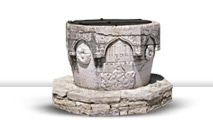
- Sečovlje Salt Pans - Dragonja River Valley
- Sv. Peter - Nova vas - Padna
- Pomjan - Nature Park: Karst Edge - Socerb
- Črni Kal - Osp - Kubed
- Momjan - Grožnjan - Pietrapelosa - Mirna
- Baštija - Kostanjica - Parenzana
- Oprtalj - Završje - Livade - Zrenj
- Istarske toplice - Motovun Forest - Višnjan
- Cave Mramornica - Feštini Kingdom - Cave Baredine
- Lim Bay - Kloštar - Kontija - Dvigrad
- Kanfanar - Bale - Palud - Vodnjan -Islands Brijuni - Fažana
- Svetvinčenat - Tinjan - Pićan - Gračišće
- Belaj - Šumber - Kožljak - Paz
- Čepićko Field - Kršan - Boljun Castle - Lupoglav
- Plomin - Kvarner Gulf - Brseč
- Nature park Učka - Mošćenice
Istarske toplice - Motovun Forest - Višnjan
Višnjan
This area was long before intersected by Roman roads that branched from the Via Flavia, the main road that connected Trieste, Poreč, Pula and Rijeka, and formed approach roads to certain inhabited sites.
In the middle of this area lies Višnjan, a town whose history reaches back to the 2nd c. BC. After the Roman conquest of the Histri, Istria became part of the 10th Italic province and Višnjan became part of the ager of Poreč area. This is when it was named Vicinianus, probably after the Roman veteran who acquired that fundus. The newer history of Višnjan began with the fall of the Roman Empire and the development of the village dedicated to agriculture and cattle breeding in the following centuries. The first written document mentioning Vissignano dates from the 13th c. This time was marked by disputes about charging statute labor, between the Poreč and Motovun nobility, who then owned the greater area of Višnjan. Since Motovun surrendered to them in the 13th c., the fate of this area too, was related to Venice. The documents of Venetian notaries speak of estate-owners, bishops and captains. The arrival of the Turks in the 15th c. encouraged the reconstruction of the walls, but the subsequent development of the village was interrupted by the plague, decimating the population in the end of the 16th c. The Venetian Republic therefore settled Croats fleeing from Dalmatia before the Turkish invasion.
Under the Austrian administration Višnjan gained the status of a city. The municipal coat of arms was defined, the construction of the new, larger church on site of the earlier one began. It had a facade facing the south in front of which a large municipal cistern was built.
During World War II, Višnjan shared the destiny of other parts of Istria, it suffered heavy losses, actively inscribing its name in the history of major events and battles. The town attractions include the Parish Church of SS. Quiricus and Julitta, the 28 meter-high belfry, the Sinčić Palace, the Church of St. Anthony the Hermit with frescoes and a Glagolitic inscription from the 14th c. and town loggia from the 17th c.



















